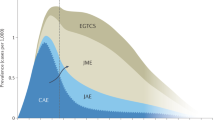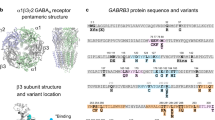Abstract
Epilepsies affect at least 2% of the population at some time in life, and many forms have genetic determinants1,2. We have found a mutation in a gene encoding a GABAA receptor subunit in a large family with epilepsy. The two main phenotypes were childhood absence epilepsy (CAE) and febrile seizures (FS). There is a recognized genetic relationship between FS and CAE, yet the two syndromes have different ages of onset, and the physiology of absences and convulsions is distinct. This suggests the mutation has age-dependent effects on different neuronal networks that influence the expression of these clinically distinct, but genetically related, epilepsy phenotypes. We found that the mutation in GABRG2 (encoding the γ2-subunit) abolished in vitro sensitivity to diazepam, raising the possibility that endozepines do in fact exist and have a physiological role in preventing seizures.
This is a preview of subscription content, access via your institution
Access options
Subscribe to this journal
Receive 12 print issues and online access
$209.00 per year
only $17.42 per issue
Buy this article
- Purchase on Springer Link
- Instant access to full article PDF
Prices may be subject to local taxes which are calculated during checkout



Similar content being viewed by others
References
Hauser, W.A., Annegers, J.F. & Kurland, L.T. Incidence of epilepsy and unprovoked seizures in Rochester, Minnesota: 1935–1984. Epilepsia 34, 453–468 (1993).
Commission on Classification and Terminology of the International League Against Epilepsy. Proposal for revised classification of epilepsies and epileptic syndromes. Epilepsia 30, 389–399 (1989).
Steinlein, O.K. et al. A missense mutation in the neuronal nicotinic acetylcholine receptor α4 subunit is associated with autosomal dominant nocturnal frontal lobe epilepsy. Nature Genet. 11, 201–203 (1995).
Biervert, C. et al. A potassium channel mutation in neonatal human epilepsy. Science 279, 403–406 (1998).
Charlier, C. et al. A pore mutation in a novel KQT-like potassium channel gene in an idiopathic epilepsy family. Nature Genet. 18, 53–55 (1998).
Singh, N.A. et al. A novel potassium channel gene, KCNQ2, is mutated in an inherited epilepsy of newborns. Nature Genet. 18, 25–29 (1998).
Wallace, R.H. et al. Febrile seizures and generalized epilepsy associated with a mutation in the Na+-channel β1 subunit gene SCN1B. Nature Genet. 19, 366–370 (1998).
Escayg, A. et al. Mutations of SCN1A, encoding a neuronal sodium channel, in two families with GEFS+2. Nature Genet. 24, 343–345 (2000).
De Fusco, M. et al. The nicotinic receptor β2 subunit is mutant in nocturnal frontal lobe epilepsy. Nature Genet. 26, 275–276 (2000).
Scheffer, I.E. & Berkovic, S.F. Genetics of the epilepsies. Curr. Opin. Pediatr. 12, 536–542 (2000).
Snead, O.C., Depaulis, A., Vergnes, M. & Marescaux, C. Absence epilepsy: advances in experimental animal models. Adv. Neurol. 79, 253–278 (1999).
Sander, T. et al. Exclusion of linkage between idiopathic generalized epilepsies and the GABAA receptor α 1 and γ 2 subunit gene cluster on chromosome 5. Epilepsy Res. 23, 235–244 (1996).
Sander, T. et al. Linkage analysis between idiopathic generalized epilepsies and the GABA(A) receptor α5 and β3 and γ3 subunit gene cluster on chromosome 15. Acta Neurol. Scand. 96, 1–7 (1997).
Sander, T. et al. Association analysis of exonic variants of the gene encoding the GABAB receptor and idiopathic generalized epilepsy. Am. J. Med. Genet. 88, 305–310 (1999).
Fong, G.C. et al. Childhood absence epilepsy with tonic-clonic seizures and electroencephalogram 3–4-Hz spike and multispike-slow wave complexes: linkage to chromosome 8q24. Am. J. Hum. Genet. 63, 1117–1129 (1998).
Feucht, M. et al. Possible association between childhood absence epilepsy and the gene encoding GABRB3. Biol. Psychiatry 46, 997–1002 (1999).
Italian League Against Epilepsy Genetic Collaborative Group. Concordance of clinical forms of epilepsy in families with several affected members. Epilepsia 34, 819–826 (1993).
Kucken, A.M., Wagner, D.A., Ward, P.R., Boileau, J.A. & Czajkowski, C. Identification of benzodiazepine binding site residues in the γ2 subunit of the γ-aminobutyric acid(A) receptor. Mol. Pharmacol. 57, 932–939 (2000).
Draguhn, A., Verdorn, T.A., Ewert, M., Seeburg, P.H. & Sakmann, B. Functional and molecular distinction between recombinant rat GABAA receptor subtypes by Zn2+. Neuron 5, 781–788 (1990).
Knudsen, F.U. Febrile seizures: treatment and prognosis. Epilepsia 41, 2–9 (2000).
Olsen, R.W. & Avoli, M. GABA and epileptogenesis. Epilepsia 38, 399–407 (1997).
Steriade, M., McCormick, D.A. & Sejnowski, T.J. Thalamocortical oscillations in the sleeping and aroused brain. Science 262, 679–685 (1993).
Brooks-Kayal, A.R. & Pritchett, D.B. Developmental changes in human γ-aminobutyric acid A receptor subunit composition. Ann. Neurol. 34, 687–693 (1993).
Scheffer, I.E. & Berkovic, S.F. Generalized epilepsy with febrile seizures plus—a genetic disorder with heterogeneous clinical phenotypes. Brain 120, 479–490 (1997).
Lathrop, G.M. & Lalouel, J.M. Easy calculations of lod scores and genetic risks on small computers. Am. J. Hum. Genet. 36, 460–465 (1984).
Cottingham, R.W., Idury, R.M. & Schaffer, A.A. Faster sequential genetic linkage computations. Am. J. Hum. Genet. 53, 252–263 (1993).
Schaffer, A.A., Gupta, S.K., Shriram, K. & Cottingham, R.W. Avoiding recomputation in linkage analysis. Hum. Hered. 44, 225–237 (1994).
Acknowledgements
We thank B. Cromer for discussions and the family for participation. Supported by the National Health & Medical Research Council, Australian Research Council, Women's & Children's Hospital Foundation, National Heart Foundation, Bionomics Limited and a University of Melbourne Scholarship (to C.M.).
Author information
Authors and Affiliations
Corresponding author
Rights and permissions
About this article
Cite this article
Wallace, R., Marini, C., Petrou, S. et al. Mutant GABAA receptor γ2-subunit in childhood absence epilepsy and febrile seizures. Nat Genet 28, 49–52 (2001). https://doi.org/10.1038/ng0501-49
Received:
Accepted:
Issue Date:
DOI: https://doi.org/10.1038/ng0501-49
This article is cited by
-
Genetic mechanisms in generalized epilepsies
Acta Epileptologica (2023)
-
Pharmacological activation of ATF6 remodels the proteostasis network to rescue pathogenic GABAA receptors
Cell & Bioscience (2022)
-
Genetic generalized epilepsies in adults — challenging assumptions and dogmas
Nature Reviews Neurology (2022)
-
Neocortex- and hippocampus-specific deletion of Gabrg2 causes temperature-dependent seizures in mice
Cell Death & Disease (2021)
-
Ameliorative effect of curcumin on altered expression of CACNA1A and GABRD in the pathogenesis of FeCl3-induced epilepsy
Molecular Biology Reports (2020)



